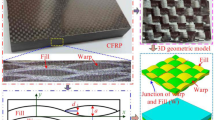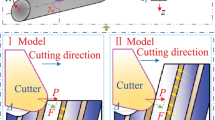Abstract
Substrate damage brings great challenges to the efficient and nondestructive removal of aircraft skin coatings. Variable load erosion tests of unidirectional carbon fiber reinforced plastic along different fiber orientations were carried out. The effects of different fiber orientations on the erosion mechanism of CFRP are discussed separately. The matrix resin is squeezed and accumulated as platelets due to the erosion of the particles, and these platelets are removed due to repeated impacts of subsequent abrasives. The epoxy resin on the top layer of the laminate is penetrated by the particles with increased energy loss, and the fiber breakage is attributed to the direct impact of the particles on the carbon fiber. Fiber fractures are divided into micro-brittle fractures and macro-brittle fractures. Cracks are initiated by the concentrated stress of particle extrusion and propagate between the graphite crystallites, resulting in irregular micro-brittle fracture and fiber failure. Under the condition of macro-brittle fracture, the fiber will be debonded, flexural deformed, and even lost under the concentrated stress of particle extrusion. The purpose of this study is to provide a theoretical reference on the mechanism by which nondestructive and efficient removal of stealth coatings can be achieved on aircraft skins.















Similar content being viewed by others
Availability of data and material
The datasets generated during and/or analyzed during the current study are available from the corresponding author on reasonable request.
Code availability
Not applicable.
References
Yang H, Liu HX, Gao RX, Liu X, Yu X, Song F, Liu LS (2022) Numerical simulation of paint stripping on CFRP by pulsed laser. Opt Laser Technol 145:107450. https://doi.org/10.1016/j.optlastec.2021.107450
Young CN, Clayton CR, Wynne JH, Yesinowski JP, Daniels GC (2015) Physicochemical investigation of chemical paint removers. II: role and mechanism of phenol in the removal of polyurethane coatings. Prog Org Coat 88:212–219. https://doi.org/10.1016/j.porgcoat.2015.06.014
Obrosov A, Gulyaev R, Ratzke M, Volinsky A, Bolz S, Naveed M, Weiß S (2017) XPS and AFM investigations of Ti-Al-N coatings fabricated using DC Magnetron sputtering at various nitrogen flow rates and deposition temperatures. Metals-Basel 7:52–62. https://doi.org/10.3390/met7020052
Ouyang J, Mativenga P, Goffin N, Liu W, Liu Z, Mirhosseini N, Jones L, Woolley E, Li L (2022) Energy consumption and performance optimisation of laser cleaning for coating removal. CIRP J Manuf Sci Tec 37:245–257. https://doi.org/10.1016/j.cirpj.2022.02.001
Palmieri FL, Belcher MA, Wohl CJ, Blohowiak KY, Connell JW (2016) Laser ablation surface preparation for adhesive bonding of carbon fiber reinforced epoxy composites. Int J Adhes Adhes 68:95–101. https://doi.org/10.1016/j.ijadhadh.2016.02.007
An S, Foest R, Fricke K, Riemer H, Fröhlich M, Quade A, Schäfer J, Weltmann K-D, Kersten H (2021) Pretreatment of cutting tools by plasma electrolytic polishing (PEP) for enhanced adhesion of hard coatings. Surf Coat Tech 405:126504. https://doi.org/10.1016/j.surfcoat.2020.126504
Chen FJ, Miao XL, Tang Y, Yin SH (2017) A review on recent advances in machining methods based on abrasive jet polishing (AJP). Int J Adv Manuf Tech 90:785–799. https://doi.org/10.1007/s00170-016-9405-7
Lv Z, Hou RG, Huang CZ, Zhu HT, Wang J (2018) Investigation on erosion mechanism in ultrasonic assisted abrasive waterjet machining. Int J Adv Manuf Tech 94:3741–3755. https://doi.org/10.1007/s00170-017-0995-5
Gomez-Guarneros MA, Dominguez-Cabrera BA, Quinto-Saure C, Farfan-Cabrera LI, Santander-Reyes JN, Gallardo-Hernandez EA (2022) Investigating the erosive wear caused by dry-ice blasting in paint stripping process. Mater Lett 308:131203. https://doi.org/10.1016/j.matlet.2021.131203
Dhau J, Wickramaratne C (2022) Thick elastomeric coating removal using tailored infrared- and infrared-sonication hybrid technology. Prog Org Coat 167:106798. https://doi.org/10.1016/j.porgcoat.2022.106798
Pauli R, Owens C (1991) Use of plastic media blast (PMB) on composite surfaces. SAE Tech Pap Series 910931(100):51–70. https://doi.org/10.4271/910931
Zhu YS, Lu WZ, Zuo DW, Xiao HP, Cao DW, Ko TJ, Wu J, Yin YX (2019) Development of abrasive jet polishing by using amino thermosetting plastic abrasive for aluminum alloy. J Manuf Process 43:218–228. https://doi.org/10.1016/j.jmapro.2019.05.016
Ben-Ami Y, Uzi A, Levy A (2016) Modelling the particles impingement angle to produce maximum erosion. Powder Technol 301:1032–1043. https://doi.org/10.1016/j.powtec.2016.07.041
Hadavi V, Moreno CE, Papini M (2016) Numerical and experimental analysis of particle fracture during solid particle erosion, part I: modeling and experimental verification. Wear 356–357:135–145. https://doi.org/10.1016/j.wear.2016.03.008
Zang XR, Cao XW, Zhang J, Xie ZQ, Xiong N, Darihaki F, Bian J (2022) Investigation of surface damage of ductile materials caused by rotating particles. Wear 488–489:204185. https://doi.org/10.1016/j.wear.2021.204185
Li WY, Wang J, Zhu H, Li H, Huang C (2013) On ultrahigh velocity micro-particle impact on steels—a single impact study. Wear 305:216–227. https://doi.org/10.1016/j.wear.2013.06.011
Qi H, Fan JM, Wang J, Li HZ (2016) On the erosion process on quartz crystals by the impact of multiple high-velocity micro-particles. Tribol Int 95:462–474. https://doi.org/10.1016/j.triboint.2015.12.003
Cai F, Gao F, Pant S, Huang X, Yang Q (2016) Solid particle erosion behaviors of carbon-fiber epoxy composite and pure titanium. J Mater Eng Perform 25:290–296. https://doi.org/10.1007/s11665-015-1848-8
Yan ML, Jiao WC, Yang F, Ding GN, Zou HR, Xu ZH, Wang RG (2019) Simulation and measurement of cryogenic-interfacial-properties of T700/modified epoxy for composite cryotanks. Mater Design 182:108050. https://doi.org/10.1016/j.matdes.2019.108050
Zhang GG, Sun YL, Gao H, Zuo DW, Liu X (2021) A theoretical and experimental investigation of particle embedding and erosion behaviour of PDMS in micro-abrasive air-jet machining. Wear 486–487:204118. https://doi.org/10.1016/j.wear.2021.204118
Papini M, Spelt JK (1998) The plowing erosion of organic coatings by spherical particles. Wear 222:38–48. https://doi.org/10.1016/S0043-1648(98)00274-9
Brach RM (1988) Impact dynamics with applications to solid particle erosion. Int J Impact Eng 7:37–53. https://doi.org/10.1016/0734-743X(88)90011-5
Wielki N, Sonnenberg H, Meyer D, Clausen B (2021) Particle-oriented peening as method to investigate the material dependent deformation behaviour. J Mater Process Tech 289:116960. https://doi.org/10.1016/j.jmatprotec.2020.116960
Arani NH, Rabba W, Papini M (2019) Solid particle erosion of epoxy matrix composites reinforced by Al2O3 spheres. Tribol Int 136:432–445. https://doi.org/10.1016/j.triboint.2019.04.010
Krishnan AV, Lim CYH (2021) Elucidating the specific and combined effects of particle size, impact angle, velocity and stress from an external load on the slurry erosion of mild steel S275JR. J Mater Res Technol 14:1052–1064. https://doi.org/10.1016/j.jmrt.2021.07.013
Xie ZQ, Cao XW, Fu CY, Zhang J, Sun XY, Wu C, Zhao XY (2021) Experimental study on the repeated impact of sharp particles on metal surface. Wear 474–475:203716. https://doi.org/10.1016/j.wear.2021.203716
Suresh A, Harsha AP, Ghosh MK (2009) Solid particle erosion of unidirectional fibre reinforced thermoplastic composites. Wear 267:1516–1524. https://doi.org/10.1016/j.wear.2009.03.041
Barkoula NM, Karger-Kocsis J (2002) Solid particle erosion of unidirectional GF reinforced EP composites with different fiber/matrix adhesion. J Reinf Plast Comp 21:1377–1388. https://doi.org/10.1106/073168402023779
Zhou R, Lu DH, Jiang YH, Li QN (2005) Mechanical properties and erosion wear resistance of polyurethane matrix composites. Wear 259:676–683. https://doi.org/10.1016/j.wear.2005.02.118
Funding
This work was supported by the Joint Funds of the National Natural Science Foundation of China (Grant No. U20A20293). The National Natural Science Foundation of China (No. 52075254); Jiangsu Science and Technology Planning Project (industry foresight and common key technologies) (BE 2018072).
Author information
Authors and Affiliations
Contributions
Yangyang Zhao: investigation, data curation, visualization, writing-original draft, and methodology. Wenzhuang Lu: project administration, funding acquisition, writing-review and editing, and supervision. Yansong Zhu: resources, writing-review and editing, and supervision. Dunwen Zuo: conceptualization and supervision.
Corresponding author
Ethics declarations
Ethics approval
Not applicable.
Consent to participate
Not applicable.
Consent for publication
Not applicable.
Competing interests
The authors declare no competing interests.
Additional information
Publisher's Note
Springer Nature remains neutral with regard to jurisdictional claims in published maps and institutional affiliations.
Rights and permissions
About this article
Cite this article
Zhao, Y., Lu, W., Zhu, Y. et al. Erosion mechanism and damage behavior of CFRP in plastic abrasive jet machining. Int J Adv Manuf Technol 121, 4905–4918 (2022). https://doi.org/10.1007/s00170-022-09667-2
Received:
Accepted:
Published:
Issue Date:
DOI: https://doi.org/10.1007/s00170-022-09667-2




